The Olympic Mountains range in western Washington State next to the Pacific Ocean on the United States’ western coast contains some of the most stunning mountain peaks in North America. Some of the most prominent mountain peaks even reach high above 7,000 feet of elevation in the range that contains 244 named mountains, ridgeline, and deep valleys.
This article lists the top ten tallest peaks in the Olympic Mountains so that you can learn all about them and come to appreciate what makes each unique. Let’s jump in and learn about the tallest peaks in the Olympic Mountains now, starting with a brief overview of the Olympic Mountains and Olympic National Park. We will also cover how to rank mountain peaks. From there, we will discuss the top ten peaks in the Olympic Mountains and finish the article with a chart covering the basic facts of each. Let’s jump in together now!
About the Olympic Mountains
Inside Olympic National Park in Washington State, tall peaks, valleys, and ridges cut across the landscape. The park itself contains vast montane forests, steep slopes, subalpine forests, alpine meadows and lakes, glaciers, rocky peaks, and even a rainforest that receives about 12 feet of rainfall each year. Located in western Washington, the Olympic Mountains stretch up to the Pacific Ocean and cross the counties of Clallam, Grays Harbor, Jefferson, and Mason. The Olympic Mountains stretch along the Olympic Peninsula, a part of Washington state that reaches across the Puget Sound, and includes 244 named mountains in the range. There are several peaks that reach higher than 7,000 feet in elevation, but the spectacular Olympic Mountain views mainly come from the stunning rugged peaks, forested foothills, and steep mountainsides. The Olympic National Park also contains about 60 glaciers, and several mountains are home to glacial systems.
Each year, more than 3 million visitors come to western Washington to hike beautiful mountain pass trails or even ascend some of the Olympic Mountain peaks. Most of the popularly-climbed mountains are among the lowest in the mountain range.
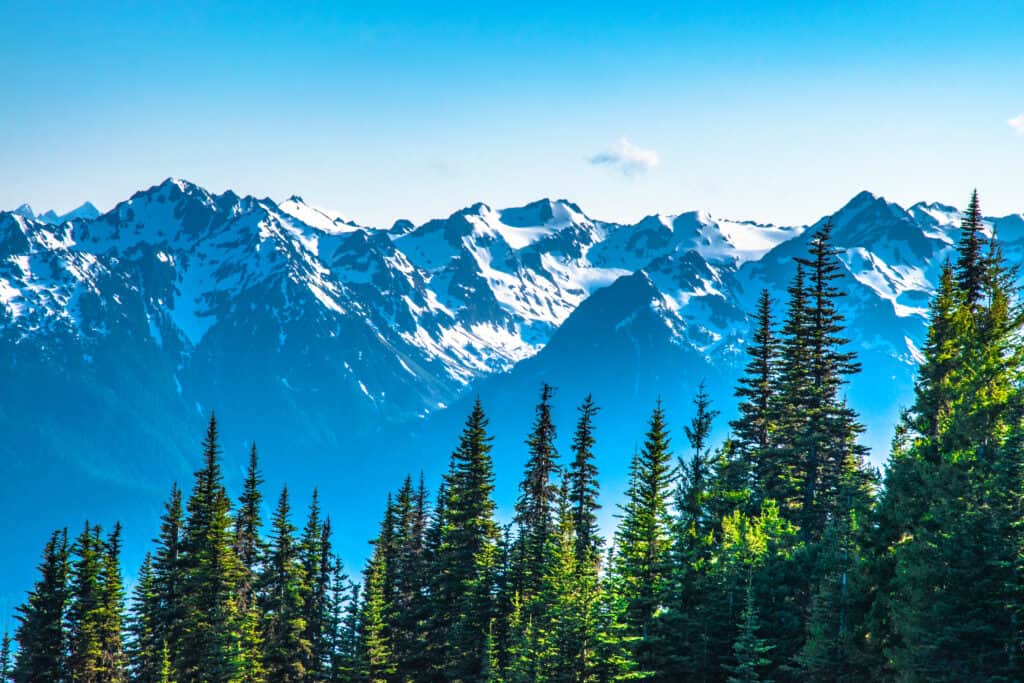
The Olympic Mountains in Washington are almost as iconic as the Alaska Mountain Range for their snow-capped peaks.
©Jeremy Janus/Shutterstock.com
The Tallest Olympic Mountains
Now that you know a bit about the Olympic Mountains and Olympic National Park, it is time to discuss the ranking of the peaks from the tallest to the tenth-tallest. Before we jump into the list, it may be helpful to cover the way that topographers rank mountains by height and prominence. There are a lot of different ways to go about measuring a mountain! One way is to count a mountain’s overall height. However, mountain climbers and topographers alike are fascinated by another measure: topographic prominence.
What is topographic prominence? In short, it is the height between a mountain’s summit and the lowest contour line that encircles the mountain and not any other higher mountain. For example, Mount Everest is the tallest mountain peak in the Himalayan Mountain range. Its prominence is the same as its total height: 29,029 feet. However, the nearby Mount Lhotse, which reaches a similarly staggering height, of 27,940 feet, does not get to claim mountain prominence because Mount Everest claims prominence.
Some people value counting a mountain’s prominence instead of simply measuring its elevation because that can help to avoid ranking the same mountain multiple times if it has several peaks. In light of this, the table at the bottom of this article includes the top ten tallest individual mountain peaks. However, it also includes other peaks that are lower peaks of mountains ranked on the list.
1. Mount Olympus
First on the list of tallest mountains in the Olympic Mountain range is Mount Olympus. At 7,969 feet in elevation, Mount Olympus nearly clears 8,000 feet and is the tallest in the range. Located in the Central Olympic Mountains, Mount Olympus is the most famous and most prominent mountain in the Olympic Mountain range, with a prominence of 7,841 feet. However, depending on a viewer’s location, it may not be the most visible.
Mount Olympus is relatively low in latitude and does not have the most significant elevation, but it does experience a significant amount of winter snow. As a result, this mountain supports large glaciers. The glaciers of Mount Olympus include Blue, Hoh, Humes, Jeffers, Hubert, Black Glarier, and White. The highest neighbor near Mount Olympus is Seward Peak.
The Middle Peak of Mount Olympus reaches 7,933 feet in elevation and the East Peak, also known as the “false summit” reaches 7,880 feet in elevation. The “true summit” is the West Peak of Mount Olympus, which can take three or four days to climb.
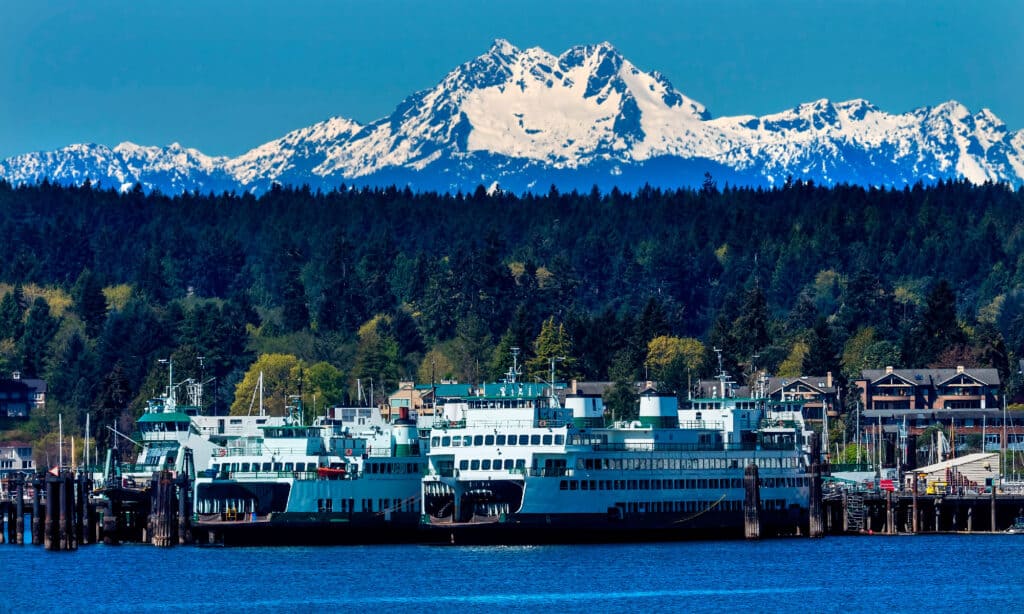
Mount Olympus is the tallest peak in the Olympic Mountains and reaches an incredible 7,933 feet in elevation.
©Danita Delimont/Shutterstock.com
2. Mount Deception
Second on the list is Mount Deception, a mountain peak in the North-Central part of the Olympic Mountains. Mount Deception has 7,788 feet in elevation. It is the second-highest peak in the Olympic Mountain range and the 17th most-prominent peak in Washington State. The challenging hike up to the mountain’s summit takes three to four days, but should only be attempted by experienced climbers since it will involve steep, exposed climbing and technical skill.
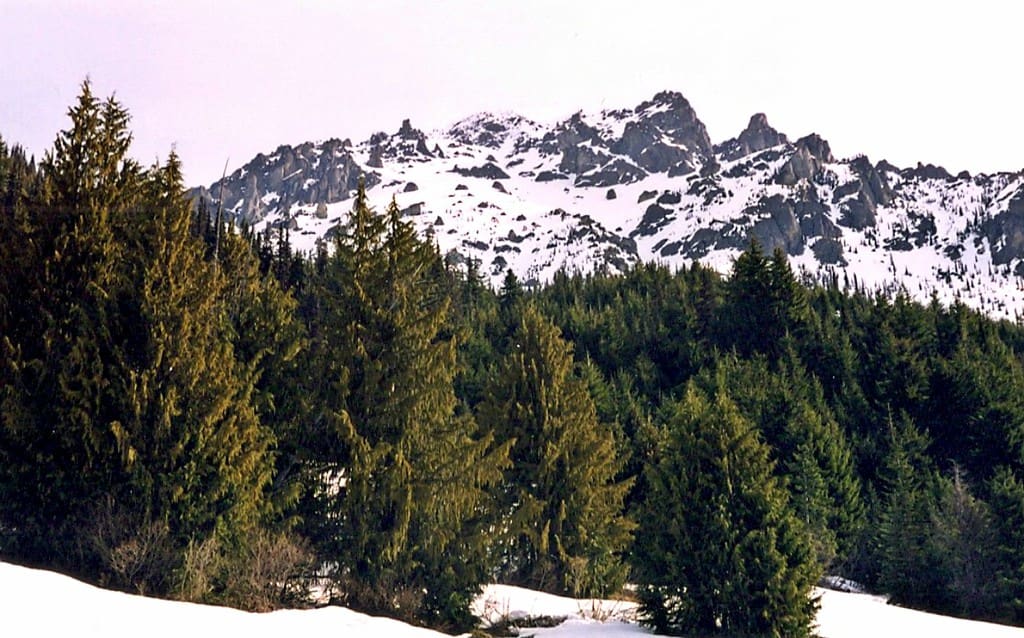
Mount Deception is the second-tallest peak in the Olympic Mountain range.
©Ron Clausen / CC BY-SA 4.0 – License
3. Mount Constance
Mount Constance, located in the Eastern part of the Olympic Mountains, is the third-highest in the range. It is also the most visible peak for viewers looking from the major Washington city of Seattle. As a result, this is one of the most well-recognized peaks for many residents of Washington and visitors to the Seattle area.
At 7,756 feet tall, Mount Constance is also said to be one of the most challenging mountains to climb in the Olympic Mountain range.
Summitting this peak offers beautiful, panoramic views across some of the other largest mountains in the range, including Mount Mystery, Mount Deception, and Mount Olympus.

Mount Constance is in the Eastern region of the Olympic Mountains.
©Ron Clausen / CC BY-SA 4.0 – License
4. Mount Johnson
Mount Johnson stands at 7,680 feet high, making it the fourth-highest mountain peak in the Olympic Mountain range. It is also the tallest peak in the Needles, a subset mountain range contained within the Olympic Mountains. Nearby Mount Deception, which is about 1.3 miles south of Mount Johnson, is the closest neighbor. It stands just slightly higher than Mount Johnson. Mount Johnson is in Jefferson County, Washington.
Though climbing Mount Johnson may not require as much technical climbing skill as some other hikes in the Olympic Mountains, it is a steep and exposed climb. As a result, it is a difficult scramble upward, but one that can result in beautiful views.
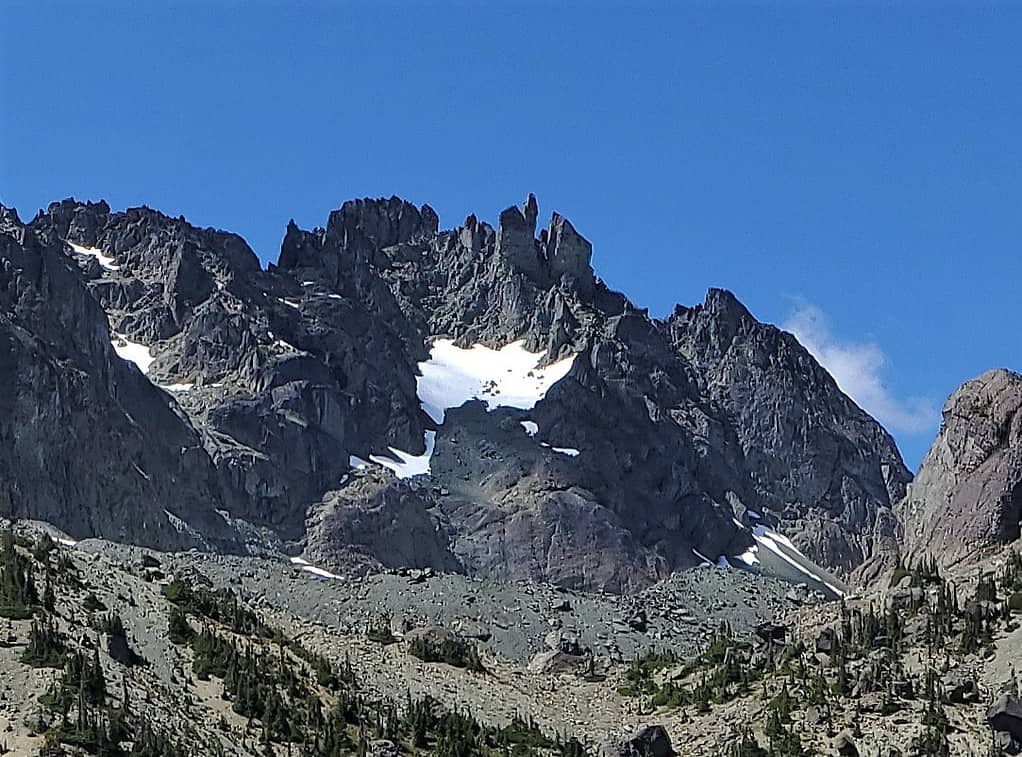
Hikers who attempt to climb Mount Johnson will find themselves doing a steep, exposed climb up sheer rock faces.
©Dan Nevill / CC BY 2.5 – License
5. Inner Constance
Just about a mile to the west of the third-highest mountain, Mount Constance, stands the fifth-tallest peak in the Olympic Mountains: Inner Constance. Inner Constance is a bit shorter than Mount Constance and helps to form the alternative side of Avalanche Canyon. Avalanche Canyon is a deep canyon carved by glaciers that separates the two. At 7,670 feet tall, Inner Constance is part of the eastern Olympic Mountains.

Inner Constance is the fifth-tallest peak in the Olympic Mountain range and stands across a canyon from Mount Constance.
©Ron Clausen / CC BY-SA 4.0 – License
6. Mount Mystery
Sixth on the list of tallest mountains in the Olympic Mountain range is Mount Mystery. At 7,639 feet tall, Mount Mystery is a big, rocky mountain peak. It stands in the northeastern part of the Olympic Mountain range. Though it is often hidden by the hulking Mount Constance, you may catch a glimpse of this peak when in the south Puget Sound lowlands of Washington. Mount Mystery is a rarely climbed peak in the area, which is partially because even reaching the basin takes quite a bit of effort. However, if you can muster up the energy to try this unique climb, you will be rewarded with incredible views!

Mount Mystery is often obscured by the nearby Mount Constance, but is nevertheless one of the tallest peaks in the Olympic Mountains.
©Leaf Petersen / CC BY 2.0 – License
7. Mount Clark
Next up is Mount Clark, a peak that stands close to the larger Mount Deception and, as a result, may often be overshadowed by its taller and more prominent neighbor. However, scrambling up Mount Clark may be technically more challenging. At 7,528 feet, there is only one route up Mount Clark. This climb includes ledge climbing up the southern and eastern sides of the mountain. The long climb concludes with an exposed scramble up the north side of the summit. Mount Clark is the second-tallest peak in the Needles range, after its neighbor Mount Johnson. The highest peak near Mount Clark is in fact Mount Johnson’s Sweat Spire peak.
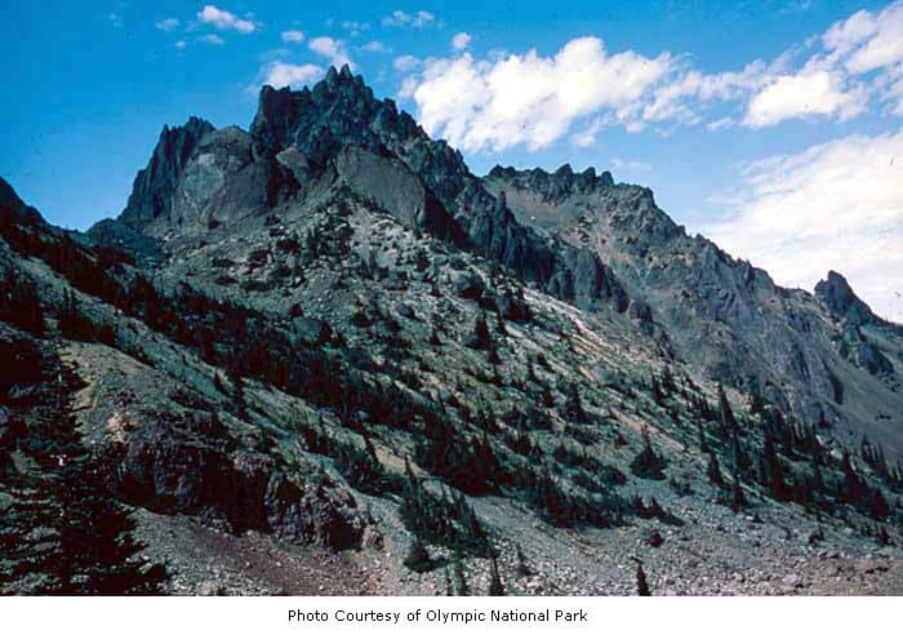
Mount Clark gives hikers a long climb followed by an intense scramble for those who hope to reach the peak.
8 & 9. Mount Anderson — West Peak and Athena
Next on the list of the top ten tallest mountains in the Olympic Mountain range is a tie for numbers 8 and 9: Mount Anderson’s West Peak and Athena. Both stand at 7,365 feet tall.
The West Peak of Mount Anderson is the highest point on the massif. Though this peak is much less frequently climbed than the 7,321 Mount Anderson peak, and it is one of the most secluded in the range, skilled technical climbers who make the trek during the summer months will be rewarded with a beautiful view. West Peak is remote but offers a vertical face that looks out over magnificent waterfalls that cascade off of sandstone rocks to form the Quinault River.
Athena, also known as Mount Olympus – South Peak, also stands at 7,365 feet tall. It matches Mount Anderson’s West Peak for height. This majestic mountain sits at the head of the Hoh Glacier in Washington’s Jefferson County. The Mount Olympus peak stands about 1.7 miles northwest. Athena has two sub-peaks: Athena II, which stands at 7,259 feet, and Athena’s Owl, which is at 7,000 feet. Mount Athena experiences a high amount of precipitation, particularly during the colder winter months. But then, in the summer, the intense Pacific Ocean high-pressure systems during the summer give no cloud cover. As a result, most people climb Athena in the late summer months. They visit between July and September when the views and climbing prospects are best.
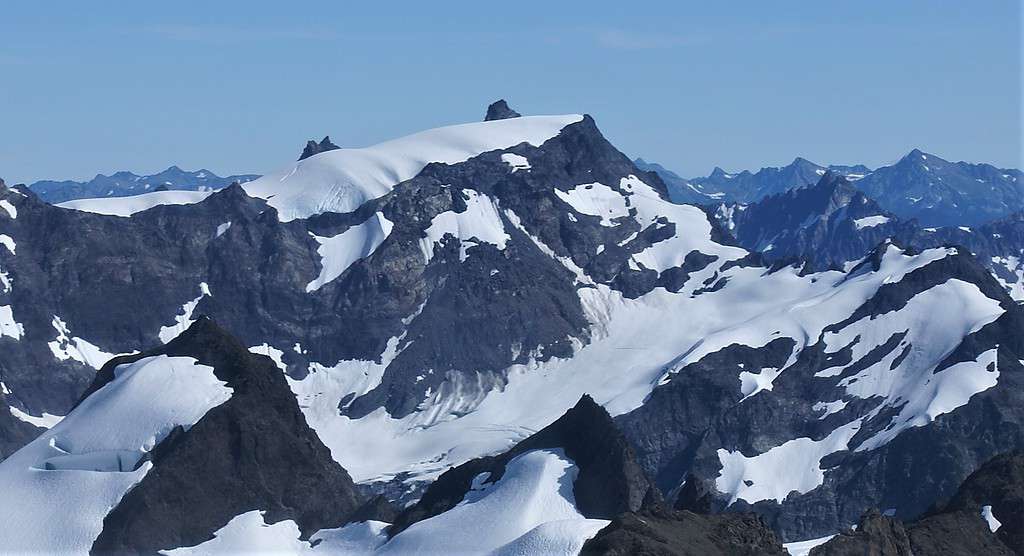
Athena is another name for the South Peak of Mount Olympus.
10. Mount Anderson
Last on the list of the top ten peaks in the Olympic Mountains is the main peak of Mount Anderson itself. The name Mount Anderson is given to the middle peak of the massif, although the West Peak (mentioned previously on this list) stands taller. In contrast, the East Peak is small and isn’t even on the list. However, Mount Anderson is also called the “Mount Olympus” of the peaks in the eastern part of the Olympic Mountain range. It gained this nickname for being the most dominant peak in the area.
Though climbing it takes enormous effort, the work will be worth it since the peak offers incredible sunrise and sunset views. At 7,321 feet, the main peak of Mount Anderson was first climbed in 1920. Since then, adventurers have tackled this hike every year starting in May and climbing into October, with snow lasting into the summer and making any attempt to summit this giant challenging and arduous.
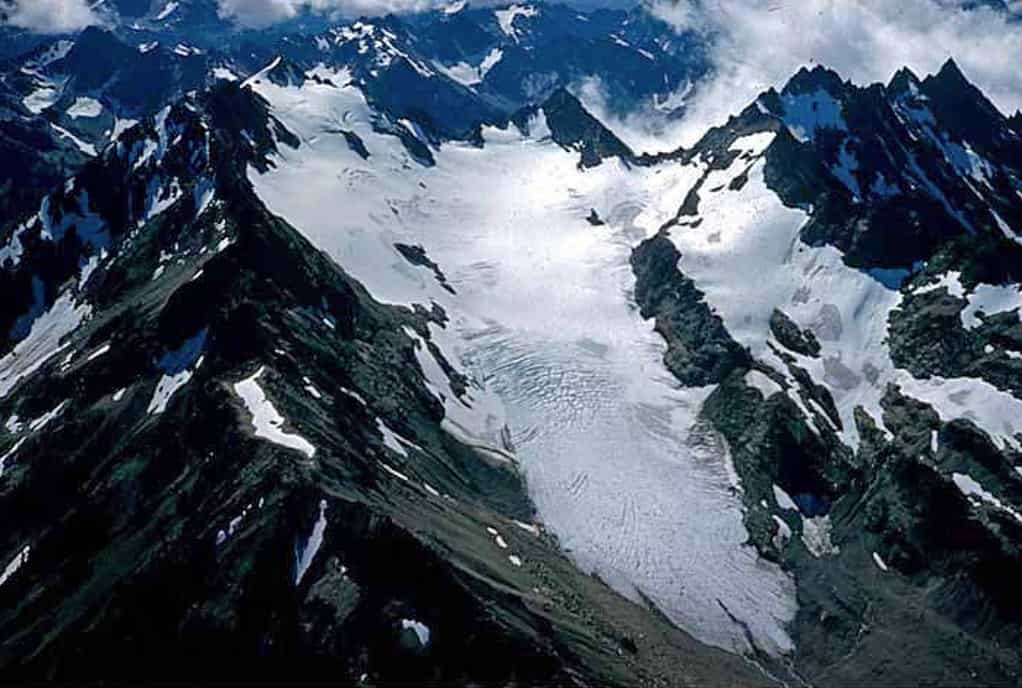
Mount Anderson is often covered in snow and ice, making a climb slow and arduous for any hiker.
Ranking the Olympic Mountains
The list above includes the top ten tallest mountain summits in the Olympic Mountains. These are summarized below with their rank, name, elevation, and which part of the range they are located in. The unranked peaks listed below are included for their elevation. However, they are not counted individually since they are lower peaks with less than 400 feet of prominence. Prominence is a topographic term. It refers to the height of a mountain compared to the vertical distance of its surrounding terrain. In order to be ranked individually, the peaks below must have 400 feet of clean prominence.
As a result, you will notice that the elevation included below includes peaks that are not given a rank. Though they have great elevation, they appear without a number in the far left column. This is because they are part of other mountains that are already ranked on this list and do not have enough clean prominence to be counted independently on this list.
Tallest Mountain Peaks in the Olympic Mountain Range
| Rank | Mountain Peak | Elevation | Range |
|---|---|---|---|
| 1 | Mount Olympus – West Peak (True Summit) | 7,969 | Central Olympic Mountains |
| Mount Olympus – Middle Peak | 7,929 | Central Olympic Mountains | |
| Mount Olympus – False Summit | 7,880 | Central Olympic Mountains | |
| 2 | Mount Deception | 7,788 | North-Central Olympic Mountains |
| Mount Olympus – East Peak | 7,762 | Central Olympic Mountains | |
| 3 | Mount Constance | 7,756 | Eastern Olympic Mountains |
| 4 | Mount Johnson | 7,680 | North-Central Olympic Mountains |
| 5 | Inner Constance | 7,670 | Eastern Olympic Mountains |
| 6 | Mount Mystery | 7,639 | North-Central Olympic Mountains |
| Martin Peak | 7,638 | North-Central Olympic Mountains | |
| Mount Mystery – North Peak | 7,600 | North-Central Olympic Mountains | |
| 7 | Mount Clark | 7,528 | North-Central Olympic Mountains |
| The Pyramid | 7,520 | North-Central Olympic Mountains | |
| Gasp Pinnacle | 7,520 | North-Central Olympic Mountains | |
| Gilhooley Tower | 7,480 | North-Central Olympic Mountains | |
| The Incisor | 7,440 | North-Central Olympic Mountains | |
| Stasis | 7,440 | North-Central Olympic Mountains | |
| Mount Walkinsaw | 7,373 | North-Central Olympic Mountains | |
| 8 & 9 (tied) | Mount Anderson – West Peak | 7,365 | Central Olympic Mountains |
| 8 & 9 (tied) | Athena | 7,365 | Central Olympic Mountains |
| C-141 Peak | 7,339 | Eastern Olympic Mountains | |
| 10 | Mount Anderson | 7,321 | Central Olympic Mountains |
The photo featured at the top of this post is © George Dodd III/Shutterstock.com
Thank you for reading! Have some feedback for us? Contact the AZ Animals editorial team.






